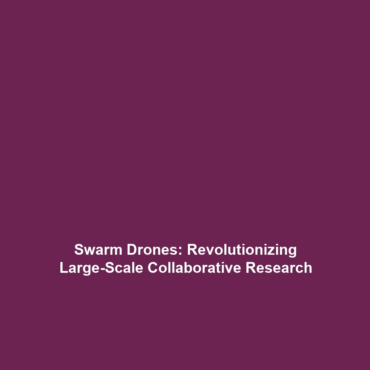Collaborative Drone Research: The Potential for Swarm Drones in Large-Scale Studies
Introduction
The emergence of swarm drones has transformed the landscape of Drones in Science. This innovative approach to collaborative drone research allows multiple drones to work together seamlessly, enhancing data collection and analysis in large-scale scientific studies. By utilizing swarm intelligence, researchers can cover vast areas more efficiently, leading to quicker and more accurate findings. Understanding the significance of these advancements is crucial as we explore the vast potential of swarm drones in various scientific fields.
Key Concepts
Swarm Intelligence in Drones
Swarm drones rely on the principles of swarm intelligence, inspired by natural systems such as bird flocks and fish schools. This decentralized approach enables the drones to communicate and adapt to changing environments, making them highly effective in large-scale studies.
Collaborative Research Methodologies
In the realm of Collaborative Drone Research, methodologies such as formation flying and dynamic task allocation are critical. These techniques enable drones to coordinate their actions, reducing overlap and improving efficiency in data collection.
Applications and Real-World Uses
The applications of swarm drones in Drones in Science are vast and varied. Here are some significant real-world uses:
- Environmental Monitoring: Swarm drones can rapidly assess environmental conditions, such as air quality and vegetation health, over extensive regions.
- Agricultural Surveys: Farmers use swarm drones for crop monitoring and yield estimation, drastically cutting down labor and time.
- Disaster Response: Swarm drones can perform search and rescue operations or assess damage post-disaster more efficiently than single-unit drones.
Current Challenges
Despite the promising future of Collaborative Drone Research, several challenges hinder widespread adoption:
- Technical Limitations: Communication failures among drones can lead to data loss and ineffective operations.
- Regulatory Hurdles: Regulations surrounding drone usage can restrict deployment, especially in populated areas.
- Data Privacy Concerns: The collection of data through drones raises questions about privacy and ethical practices.
Future Research and Innovations
Looking ahead, the field of Collaborative Drone Research is poised for significant innovations:
- Improved Algorithms: Advances in algorithms for synchronization and efficient task delegation among drones will optimize their functionality.
- Enhanced Autonomy: New technologies are developing drones that can operate with minimal human intervention, focusing on real-time decision-making.
- Integration with AI: The fusion of AI and swarm robotics promises smarter, more adaptive behaviors in collaborative drone applications.
Conclusion
In summary, Collaborative Drone Research highlights the potential of swarm drones to revolutionize data collection in Drones in Science. With their myriad applications and the prospect of overcoming current challenges, these drones are set to play a pivotal role in future scientific studies. For those interested in further exploring related topics, consider reading about advancements in drone technologies and environmental monitoring techniques.

Leave a Reply